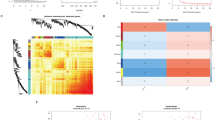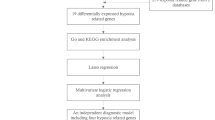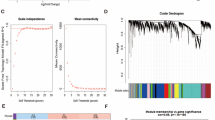Abstract
Ischemic stroke (IS) significantly impacts patients’ health and quality of life, with the roles of autophagy and autophagy-related genes in IS still not fully understood. In this study, IS datasets were retrieved from the GEO database. Autophagy-related genes(ARGs) were identified and screened for differential expression. A prediction model was constructed using machine learning algorithm. WGCNA was employed to analyze differential regulation modules among different clusters of stroke patients. The analysis results were validated using single-cell sequencing data. Finally, autophagy hub genes were validated in an external cohort and an IS mouse model. We observed suppressed autophagy states in IS patients. A diagnostic model with good clinical efficacy for stroke diagnosis was constructed based on the selected key genes (AUC = 0.87). Consensus clustering identified two IS subtypes with distinct gene expression patterns and immune cell infiltration. scRNA-seq data analysis confirmed downregulation of pexophagy in IS. CellChat analysis identified key signaling pathways and intercellular interactions related to pexophagy. Validation in an external cohort and IS mouse model confirmed differential gene expression, supporting the involvement of pexophagy in IS pathogenesis. The identified key genes, molecular subtypes, and cellular interactions provide a foundation for further research into targeted therapies and precision medicine approaches for IS patients.
This is a preview of subscription content, access via your institution
Access options
Subscribe to this journal
Receive 6 digital issues and online access to articles
$119.00 per year
only $19.83 per issue
Buy this article
- Purchase on SpringerLink
- Instant access to full article PDF
Prices may be subject to local taxes which are calculated during checkout










Similar content being viewed by others
Data availability
The data underlying this article are available in the GEO (https://www.ncbi.nlm.nih.gov/geo/) database.
Code availability
The code used to generate the results central to this study is available upon request.
References
Herpich F, Rincon F. Management of acute ischemic stroke. Crit Care Med. 2020;48:1654–63.
DeLong JH, Ohashi SN, O’Connor KC, Sansing LH. Inflammatory responses after ischemic stroke. Semin Immunopathol. 2022;44:625–48.
Paul S, Candelario-Jalil E. Emerging neuroprotective strategies for the treatment of ischemic stroke: an overview of clinical and preclinical studies. Exp Neurol. 2021;335:113518.
Mizushima N, Komatsu M. Autophagy: renovation of cells and tissues. Cell. 2011;147:728–41.
Parzych KR, Klionsky DJ. An overview of autophagy: morphology, mechanism, and regulation. Antioxid Redox Signal. 2014;20:460–73.
Ajoolabady A, Wang S, Kroemer G, Penninger JM, Uversky VN, Pratico D, et al. Targeting autophagy in ischemic stroke: from molecular mechanisms to clinical therapeutics. Pharmacol Ther. 2021;225:107848.
Beccari S, Sierra-Torre V, Valero J, Pereira-Iglesias M, García-Zaballa M, Soria FN, et al. Microglial phagocytosis dysfunction in stroke is driven by energy depletion and induction of autophagy. Autophagy. 2023;19:1952–81.
Guan R, Zou W, Dai X, Yu X, Liu H, Chen Q, et al. Mitophagy, a potential therapeutic target for stroke. J Biomed Sci. 2018;25:87.
Vargas JNS, Hamasaki M, Kawabata T, Youle RJ, Yoshimori T. The mechanisms and roles of selective autophagy in mammals. Nat Rev Mol Cell Biol. 2023;24:167–85.
Thind AS, Monga I, Thakur PK, Kumari P, Dindhoria K, Krzak M, et al. Demystifying emerging bulk RNA-Seq applications: the application and utility of bioinformatic methodology. Brief Bioinform. 2021;22:bbab259.
Hänzelmann S, Castelo R, Guinney J. GSVA: gene set variation analysis for microarray and RNA-seq data. BMC Bioinform. 2013;14:7.
Wilkerson MD, Hayes DN. ConsensusClusterPlus: a class discovery tool with confidence assessments and item tracking. Bioinformatics. 2010;26:1572–3.
Langfelder P, Horvath S. WGCNA: an R package for weighted correlation network analysis. BMC Bioinform. 2008;9:559.
Liebermeister W, Noor E, Flamholz A, Davidi D, Bernhardt J, Milo R. Visual account of protein investment in cellular functions. Proc Natl Acad Sci USA. 2014;111:8488–93.
Aibar S, González-Blas CB, Moerman T, Huynh-Thu VA, Imrichova H, Hulselmans G, et al. SCENIC: single-cell regulatory network inference and clustering. Nat Methods. 2017;14:1083–6.
Nabavi SF, Sureda A, Sanches-Silva A, Pandima Devi K, Ahmed T, Shahid M, et al. Novel therapeutic strategies for stroke: the role of autophagy. Crit Rev Clin Lab Sci. 2019;56:182–99.
Malampati S, Song JX, Chun-Kit Tong B, Nalluri A, Yang CB, Wang Z, et al. Targeting aggrephagy for the treatment of Alzheimer’s disease. Cells. 2020;9:311.
Cui W, Sathyanarayan A, Lopresti M, Aghajan M, Chen C, Mashek DG. Lipophagy-derived fatty acids undergo extracellular efflux via lysosomal exocytosis. Autophagy. 2021;17:690–705.
Picca A, Faitg J, Auwerx J, Ferrucci L, D’Amico D. Mitophagy in human health, ageing and disease. Nat Metab. 2023;5:2047–61.
Germain K, Kim PK. Pexophagy: a model for selective autophagy. Int J Mol Sci. 2020;21:578.
Cheng A, Tse KH, Chow HM, Gan Y, Song X, Ma F, et al. ATM loss disrupts the autophagy-lysosomal pathway. Autophagy. 2021;17:1998–2010.
Bingol B, Tea JS, Phu L, Reichelt M, Bakalarski CE, Song Q, et al. The mitochondrial deubiquitinase USP30 opposes parkin-mediated mitophagy. Nature. 2014;510:370–5.
Oltion K, Carelli JD, Yang T, See SK, Wang HY, Kampmann M, et al. An E3 ligase network engages GCN1 to promote the degradation of translation factors on stalled ribosomes. Cell. 2023;186:346–62.e17.
Demers ND, Riccio V, Jo DS, Bhandari S, Law KB, Liao W, et al. PEX13 prevents pexophagy by regulating ubiquitinated PEX5 and peroxisomal ROS. Autophagy. 2023;19:1781–802.
Rasmussen NL, Kournoutis A, Lamark T, Johansen T. NBR1: the archetypal selective autophagy receptor. J Cell Biol. 2022;221:e202208092.
Funding
The study was supported by the National Natural Science Foundation of China (82072159), Specialized Capacity Building Project ((2021)79), and Young Scholars Fostering Fund of the First Affiliated Hospital of Nanjing Medical University (PY2022058).
Author information
Authors and Affiliations
Contributions
Xufeng Chen and Huae Xu designed and managed the study. Yi Zhu and Wei Li responsible for designing and developing the research methods and experiments in the study. Xiaole Zhu and Zhongman Zhang conducted the statistical analysis, data interpretation, Yanlong Chen drew conclusions based on the collected data.
Corresponding author
Ethics declarations
Competing interests
The authors declare no competing interests.
Ethics approval
We confirm that all methods in this study were performed in accordance with the relevant guidelines and regulations. Animal experiments were approved by the Institutional Animal Care and Use Committee of Nanjing Medical University (Approval No. IACUC-2408015), and all procedures strictly followed institutional and international ethical guidelines for animal research.
Additional information
Publisher’s note Springer Nature remains neutral with regard to jurisdictional claims in published maps and institutional affiliations.
Supplementary information
Rights and permissions
Springer Nature or its licensor (e.g., a society or other partner) holds exclusive rights to this article under a publishing agreement with the author(s) or other rightsholder(s); author self-archiving of the accepted manuscript version of this article is solely governed by the terms of such publishing agreement and applicable law.
About this article
Cite this article
Zhu, X., Zhang, Z., Zhu, Y. et al. Comprehensive analysis of autophagy status and its relationship with immunity and inflammation in ischemic stroke through integrated transcriptomic and single-cell sequencing. Genes Immun 26, 111–123 (2025). https://doi.org/10.1038/s41435-025-00320-y
Received:
Revised:
Accepted:
Published:
Issue date:
DOI: https://doi.org/10.1038/s41435-025-00320-y



